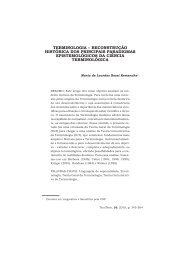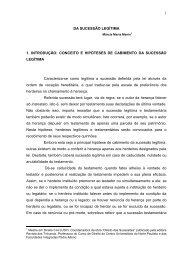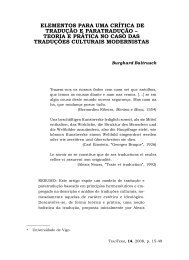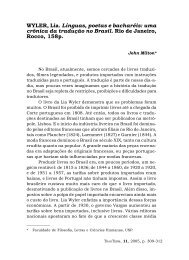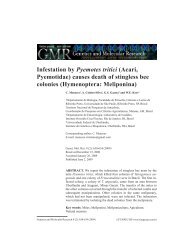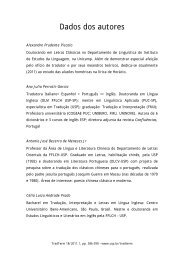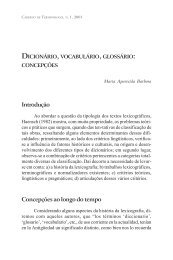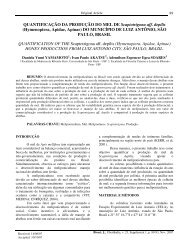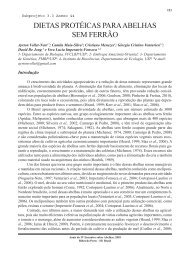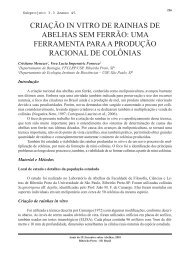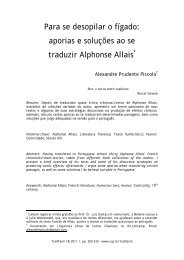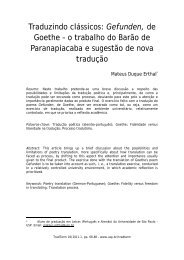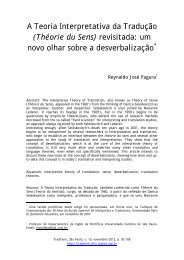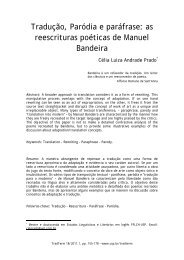Bees as pollinators in Brazil - USP
Bees as pollinators in Brazil - USP
Bees as pollinators in Brazil - USP
Create successful ePaper yourself
Turn your PDF publications into a flip-book with our unique Google optimized e-Paper software.
34<br />
established. The method should be calibrated<br />
aga<strong>in</strong>st known are<strong>as</strong> by follow-up procedures<br />
us<strong>in</strong>g species accumulation curves (Soberón &<br />
Llorente, 1993) to <strong>in</strong>form about the efficiency<br />
of the chosen design and techniques. Species<br />
accumulation curves are produced from<br />
species-by-sample matrices <strong>in</strong> a spreadsheet,<br />
and they can be carried out by the EstimateS<br />
program (Colwell, 1997).<br />
Sampl<strong>in</strong>g techniques that m<strong>in</strong>imize the<br />
collectors’ <strong>in</strong>terference are preferred, but the<br />
best results <strong>in</strong> <strong>Brazil</strong> have so far been achieved<br />
us<strong>in</strong>g hand nets. To m<strong>in</strong>imize differences<br />
among collectors, previous tra<strong>in</strong><strong>in</strong>g is mandatory.<br />
Different species have different behaviours<br />
at flowers; some of them can be very f<strong>as</strong>t and<br />
sensitive to movement. Collectors must be<br />
advised to collect any bees and all w<strong>as</strong>ps and<br />
small flies, because some bee species looks like<br />
w<strong>as</strong>ps or are too small to be differentiated<br />
from another <strong>in</strong>sect when observed <strong>in</strong> the field.<br />
Recommended techniques are hand nett<strong>in</strong>gand<br />
sweep nett<strong>in</strong>g <strong>in</strong> transects. Although<br />
pan traps have not had good acceptance<br />
among <strong>Brazil</strong>ian researchers, good results and<br />
new fluorescent colors reported from other<br />
countries speak for its use. Pan traps tend to<br />
be selective for certa<strong>in</strong> groups, so they should<br />
not be used <strong>as</strong> the only technique for <strong>in</strong>ventories.<br />
The best method may vary accord<strong>in</strong>g to<br />
site and logistics, but best results <strong>in</strong> species<br />
numbers are usually achieved when multiple<br />
methods are applied.<br />
The length of the transect needs to be<br />
standardized, but it will depend on the aim of<br />
the survey, <strong>as</strong> discussed above. If the transect<br />
is divided <strong>in</strong>to sub samples, these should be<br />
kept separated for posterior analyses. The<br />
start<strong>in</strong>g po<strong>in</strong>t of the transect should be picked<br />
at random, <strong>in</strong> order to avoid always collect<strong>in</strong>g<br />
dur<strong>in</strong>g the peak activity period at the same<br />
part of the transect. One needs to be sure that<br />
the peak activity period is always covered by<br />
sampl<strong>in</strong>g effort. Collectors should also be randomized<br />
along sites to m<strong>in</strong>imize bi<strong>as</strong> from collect<strong>in</strong>g<br />
ability.<br />
Complementary data is very important for<br />
data analysis, so a protocol should be applied<br />
to every survey. Recommended data to be<br />
gathered are the follow<strong>in</strong>g:<br />
• site location with coord<strong>in</strong>ates; use a GPS; if<br />
this is not available, report local geographic<br />
references like roads, bridges, or equivalents;<br />
• date, <strong>in</strong>clud<strong>in</strong>g month/day/year ;<br />
• time of the day, <strong>in</strong>dicat<strong>in</strong>g sampl<strong>in</strong>g hours;<br />
• a clear vegetation cl<strong>as</strong>sification, <strong>in</strong>form<strong>in</strong>g<br />
not only details about the vegetation found<br />
<strong>in</strong> the sampl<strong>in</strong>g are<strong>as</strong>, but also the characteristics<br />
of the landscape <strong>in</strong> which is it situated;<br />
• the size of the total area from which samples<br />
are taken must be <strong>in</strong>dicated, because<br />
results are expected to vary if collect<strong>in</strong>g sites<br />
are a part of a 1 ha, a 100 ha or a larger area<br />
of Cerrado;<br />
• general climate description and cl<strong>as</strong>sification<br />
are very useful and must be complemented<br />
with local weather conditions dur<strong>in</strong>g the collection<br />
days and <strong>in</strong>formation about average<br />
temperature and ra<strong>in</strong>fall whenever possible.<br />
Floral <strong>as</strong>sociations are important complementary<br />
<strong>in</strong>formation, but time can be saved if<br />
collectors add flowers to a bag, identify it, and<br />
leave a numbered tag on the plant to proceed<br />
with plant identification later on.<br />
Field equipment must <strong>in</strong>clude spare hand<br />
nets, and enough vials to avoid jamm<strong>in</strong>g various<br />
<strong>in</strong>sects <strong>in</strong>to each vial. All material is to be<br />
labeled <strong>in</strong> advance allow<strong>in</strong>g quick field <strong>in</strong>formation<br />
to be made promptly.<br />
After fieldwork some procedures are recommended<br />
that will make data e<strong>as</strong>y to analyze<br />
for anyone <strong>in</strong>terested:<br />
• standardize the format of data presentation<br />
and codes to facilitate understand<strong>in</strong>g at all<br />
<strong>in</strong>stances of the study;



